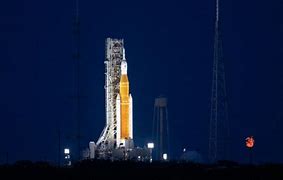
In early November, scientists at Kennedy Space Center in Florida trundled Artemis 1 rocket back to the pad in anticipation of a November 14 launch, just as Tropical Storm Nicole – soon to elevate to hurricane strength – grew on the horizon.
NASA considered moving the rocket into shelter again, but that would have entailed some risks.
Standing on the launchpad, parts of the rocket can tolerate sustained winds of up to 74 knots. But it’s more vulnerable if it’s on the crawler, the slow-moving machine that would be used to bring it indoors. In the end, there wasn’t enough time to deliver it to shelter. The team made the call to leave the rocket on the pad and push the launch date to November 16.
Hurricane Nicole brought strong winds, including some around the 74-knot level. But NASA personnel assessed that storm damage to the SLS rocket and Orion capsule was minor. A very thin strip of caulk or insulation at the base of Orion’s protective nose cone had come loose, and they detected an electrical connection issue with a cable involved in the liquid hydrogen fuelling of the rocket.
While there’s a chance more of that caulk-like material could be stripped off during launch, the Artemis team deemed this a minimal risk, said Mike Sarafin, the Artemis mission manager, at a press conference on Monday. They decided to press ahead.
“I’m extremely proud of the resilience of this team. It was a bit of a let-down when we had to roll back for Hurricane Ian, but then by the next day, everyone was super-focused on what work we needed to do. It was a similar story for Hurricane Nicole,” said Jeremy Parsons, deputy manager of NASA’s Exploration Ground Systems at Kennedy Space Center, at that press briefing.
Countdown procedures started up again at 1:24 am Eastern time on Monday. The launch team and US Space Force meteorologists confirmed that the weather was 80 per cent favourable, with no more hurricanes on the way.
The team began gradually going through their checklist of 489 launch criteria. On Tuesday afternoon, they began filling the big orange fuel tank with more than 700,000 gallons of liquid hydrogen and liquid oxygen, supercooled to a frigid –423 and –297 degrees Fahrenheit. Finally, with 10 minutes left, launch director Charlie Blackwell-Thompson and the team made the call that they were “go” for launch.
Speaking just a few minutes later, she told the team: “You have earned your place in history. You are part of a first. That doesn’t come along very often – once in a career, maybe. We are all part of something incredibly special: the first launch of Artemis. The first step in returning our country to the moon and on to Mars. What you have done today will inspire generations to come. So thank you for your resilience. The harder the climb, the better the view. We showed the Space Coast tonight what a beautiful view it is.”
Artemis 1 should be considered a “test flight,” Parson says. That means even if some conditions aren’t ideal, they’re not likely to abort the mission mid-flight. At a NASA press conference in August, Sarafin underscored this point.
“This is the first flight of a new rocket and new spacecraft, and it does carry inherent risk,” he said. “We have a ‘lean forward’ strategy to get our high-priority objective, which is to demonstrate the heat shield at reentry conditions [from the moon]. We would ‘go’ on this flight for conditions that we’d normally be ‘no go’ on a crewed flight, in the interest of crew safety.”
The Artemis team will be watching to see how Orion’s heat shield handles the scorching 5,000 degrees Fahrenheit during re-entry through the atmosphere at about 25,000 miles per hour (or Mach 32, if you’re counting).
The heat shield involves a special material called Avcoat, which is built into connected blocks at the bottom of Orion. As it heats up, parts of it slough off. Such heat shields have never been tested at the speeds a spacecraft returning from the moon will experience.
The team will also be checking to see that the communication and navigation systems work well, supplemented by NASA’s Near Space Network of ground stations in Chile and South Africa. They’ll collect radiation data from sensors worn by the three mannequins riding onboardincluding one dubbed “Commander Moonikin Campos” – plus data about the spacecraft’s trajectory an – d the temperature of the crew module.
And they will be making sure that the three parachutes deploy properly, slowing the spacecraft to about 20 miles per hour. As Orion splashes down, NASA officials will work with a Navy recovery ship, including divers and team members on inflatable boats, so that they can safely and quickly retrieve the spacecraft, since there will be astronauts aboard next time.
Orion’s return will set the stage for Artemis 2 – and for even more far-flung trips to Mars. But it all depends on a first mission that demonstrates humankind is ready to take its next giant leap.
- A Wired report











